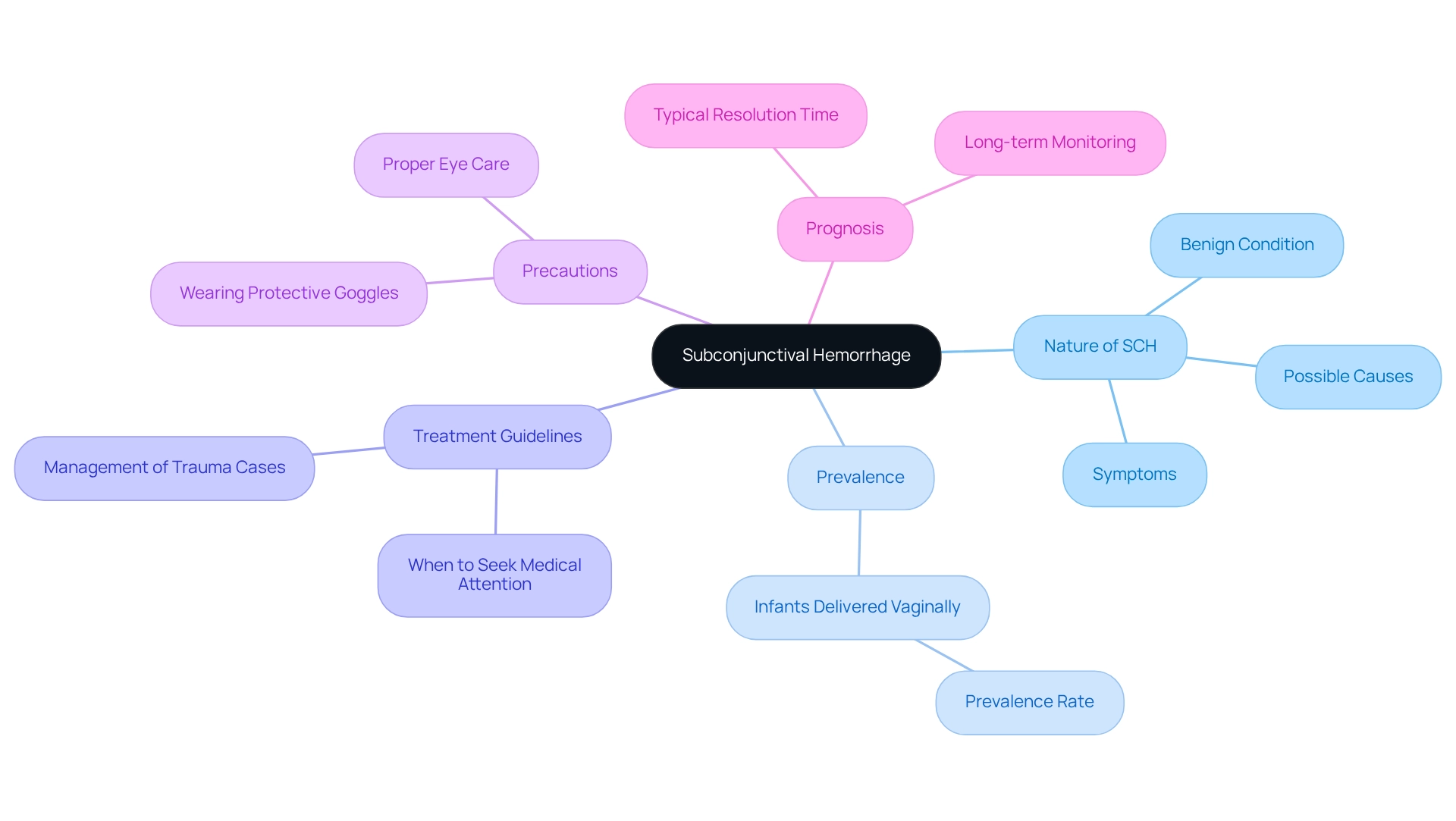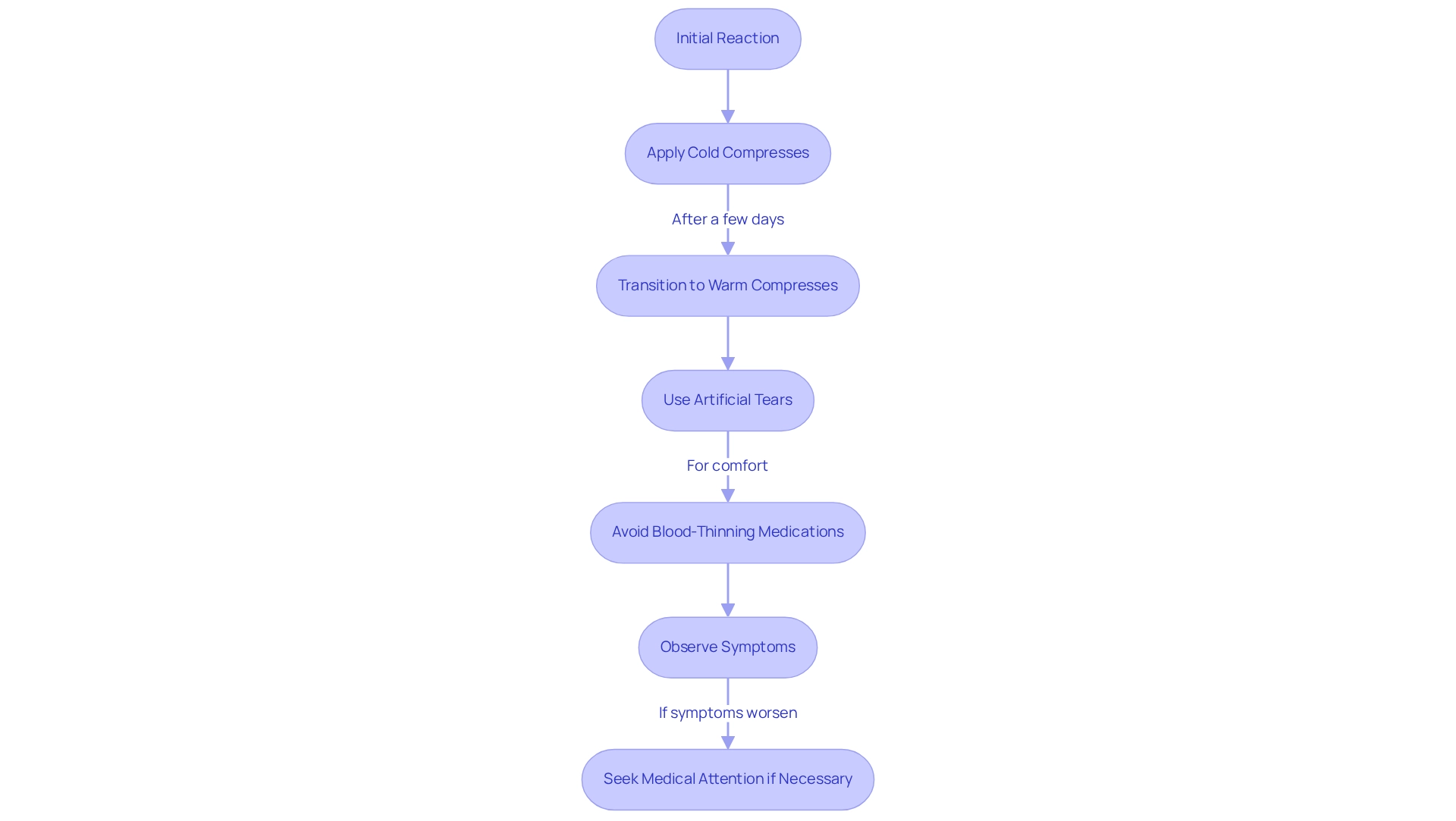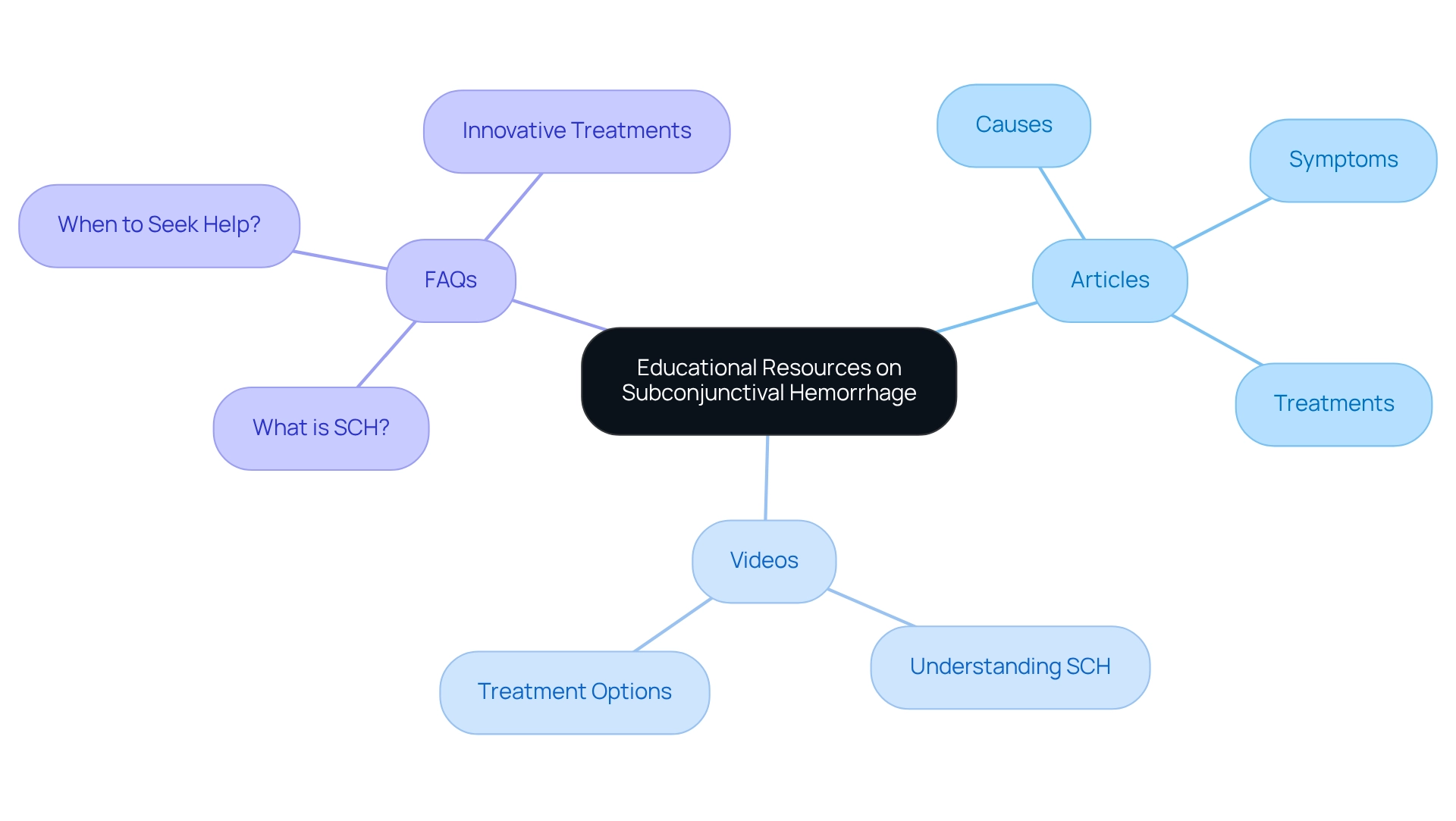Posted by: Northwest Eye in General on June 6, 2025
Overview
If you’re dealing with a subconjunctival hemorrhage, it’s important to know that there are treatments available for quick relief. We understand that this condition can be concerning, and monitoring it closely is a key first step. Applying cold and warm compresses can provide comfort, while using artificial tears helps alleviate any discomfort you may be feeling.
These methods, along with patient education and individualized care, are effective in managing symptoms and promoting recovery. They not only help reduce swelling but also improve your overall eye health. Remember, you are not alone in this journey, and we are here to help you through the process.
Introduction
In the realm of eye health, we understand that subconjunctival hemorrhage (SCH) can often raise concerns among patients. However, it’s important to know that this condition is typically benign and self-resolving. With advancements in medical knowledge and treatment options, understanding SCH is crucial for effective management.
Various medical institutions, including:
- Northwest Eye
- The Merck Manual
- Beach Eye Medical Group
emphasize the importance of tailored care, patient education, and innovative approaches to address SCH. From practical home management strategies to specialized services, the insights gathered from these sources illuminate a comprehensive pathway to navigating the complexities of subconjunctival hemorrhage.
By fostering awareness and providing accessible resources, we empower you to take charge of your eye health and ensure optimal recovery. It’s common to feel uncertain, but with the right support and information, you can confidently manage your eye health journey.
Northwest Eye: Comprehensive Treatment for Subconjunctival Hemorrhage
At Northwest Eye, we understand that experiencing subconjunctival hemorrhage can be concerning, which is why we offer various subconjunctival hemorrhage treatments. That’s why we adopt a holistic approach to subconjunctival hemorrhage treatments, prioritizing your education and individualized care. Our comprehensive range of services includes:
Our skilled ophthalmic surgeons conduct thorough assessments to determine the best course of action tailored just for you, which may involve:
- Monitoring your condition
- Recommending artificial tears for relief
- Advising you on subconjunctival hemorrhage treatments and when to seek
By utilizing advanced technology in our procedures, we offer customized treatment for each individual. This dedication not only improves your satisfaction but also aids in achieving successful results in managing eye bleeding.
We believe in the significance of in our communities, including Golden Valley, Minnetonka, Maple Grove, and beyond. Remember, we are here to help you through this process, providing the support and care you need.
Merck Manual: In-Depth Insights on Subconjunctival Hemorrhage
We understand that noticing blood in the eye can be alarming. According to the Merck Manual, subconjunctival bleeding (SCH) is typically benign and often resolves on its own within one to three weeks. While this condition may cause concern, it usually does not indicate a serious underlying issue. Subconjunctival hemorrhage treatments are generally not necessary unless accompanied by pain or changes in vision, and it’s important to note that the prevalence of SCH is reported to be between 1.7% and 46.3% for infants delivered vaginally, highlighting its occurrence in this specific population. If you or a loved one is on anticoagulant treatment, please be aware that careful observation is crucial, as there may be an increased risk for such bleeding.
Moreover, if SCH occurs without an obvious cause, it may indicate a risk of future hypertension in older individuals. This underscores the importance of being aware of potential long-term consequences. In cases of , a CT scan of the orbits may help diagnose any underlying issues, such as an occult globe rupture, indicating when medical attention is necessary.
Overall, the prognosis for SCH is favorable, with most cases resolving without intervention. By being aware of underlying conditions and adhering to treatment guidelines, outcomes can be significantly improved. If subconjunctival hemorrhage treatments are needed due to trauma or if the condition lasts longer than two days, we encourage you to seek medical attention to ensure proper management. Additionally, as a precautionary measure, wearing protective goggles during activities that pose a risk of eye injury is highly recommended. We are here to help you through this process and ensure you feel supported every step of the way.

Patient.info: Practical Management Tips for Subconjunctival Hemorrhage
Managing subconjunctival hemorrhage treatments can feel overwhelming, but there are practical strategies that can help you through this process. Initially, applying cold compresses can significantly reduce swelling and discomfort in the first few days after the incident. We understand that this can be a distressing time, and these compresses can provide some relief. After this initial period, transitioning to warm compresses can facilitate healing by improving blood circulation to the affected area. It’s common to feel anxious about medications; therefore, it’s essential to avoid blood-thinning medications, such as aspirin, unless specifically prescribed by a healthcare professional, as these can exacerbate bleeding.
In addition to compresses, using artificial tears is recommended to alleviate dryness and irritation, providing comfort during your recovery. Regular application of artificial tears can also support overall eye health, particularly if dryness is a concern. Observing your condition closely is crucial; we encourage you to seek medical attention if symptoms continue or worsen, ensuring prompt intervention if needed.
Statistics indicate that combining can lead to noticeable improvements in recovery time and symptom relief. For instance, studies have shown that patients using these compresses report a 30% faster recovery rate compared to those who do not. Eye care professionals promote these techniques, emphasizing their efficacy in managing subconjunctival hemorrhage treatments. As JSW, an executive of the Tear Film and Ocular Surface Society, states, “The use of compresses is a straightforward yet effective method for handling eye bleeding, promoting both comfort and recovery.” Case studies have shown that patients who adhere to these practical tips experience quicker recovery and reduced discomfort, underscoring the importance of proper home management strategies. By following these suggestions, you can successfully navigate the challenges of eye bleeding and encourage a smoother recovery.

Beach Eye Medical Group: Specialized Services for Eye Health
At Beach Eye Medical Group, we understand that managing eye health can be a source of concern for many individuals. Our specialized services focus on subconjunctival hemorrhage treatments, and our experienced ophthalmologists are dedicated to providing comprehensive evaluations. We recognize that a careful history and physical examination are essential in determining whether an SCH is benign or indicative of a more serious condition.
In situations where trauma is suspected, we prioritize your well-being by ensuring that emergent ophthalmology consultations are readily available to address any potential complications. We believe that client education is vital; empowering you to understand your condition and the healing process is crucial for effective recovery.
As emphasized by the National Eye Institute, maintaining awareness of eye health is important for everyone. At Beach Eye Medical Group, we utilize advanced diagnostic tools to monitor your eye health meticulously. This commitment establishes us as a trusted resource for those facing eye-related challenges.
Our dedication to personalized care not only improves outcomes but also fosters a deeper understanding of eye health management. This is especially significant for individuals with cataracts, who may be at increased risk for . Remember, we are here to help you through this process, and together, we can navigate your journey toward better eye health.
The Eye Center: Educational Resources on Subconjunctival Hemorrhage
At The Eye Center, we understand that dealing with subconjunctival hemorrhage (SCH) can be concerning. That’s why we offer an extensive array of educational resources designed to support you. Our website features a variety of articles, videos, and FAQs that explain the causes, symptoms, and associated with this condition. By providing accessible and detailed information, we aim to clarify your experience with SCH, helping you feel more informed and less anxious about your eye health.
This educational initiative is essential because studies show that engaging with educational resources significantly improves understanding and management of eye conditions. We recognize that it’s common to feel overwhelmed, especially with recent advancements in treatment, such as the use of tissue plasminogen activator. Staying informed about these innovative approaches to care is vital.
Our commitment to patient education aligns with our philosophy of empowering you through knowledge, ensuring you are equipped to make informed decisions regarding your health. This is particularly important, as SCH can occur in various populations, including newborns and children, which necessitates specialized care and understanding, especially regarding subconjunctival hemorrhage treatments. Overall, the resources we provide not only inform but also foster a proactive approach to managing subconjunctival hemorrhage. We are here to help you through this process, ensuring you feel supported every step of the way.

Conclusion
Understanding subconjunctival hemorrhage (SCH) is essential for effective eye health management. We understand that encountering SCH can be alarming, but it is typically a benign condition that resolves on its own. Insights from various medical institutions, such as Northwest Eye and Beach Eye Medical Group, stress the importance of individualized care and patient education. It’s crucial that you feel well-informed about your condition and the available treatment options.
Practical management strategies can significantly enhance your recovery and comfort. Techniques like applying cold and warm compresses, along with using artificial tears, have been shown to support healing. Research indicates that proactive home care can lead to faster recovery and reduced discomfort. Additionally, resources like the Merck Manual emphasize the importance of monitoring your symptoms and seeking medical attention when necessary, especially in cases related to trauma or persistent symptoms.
By fostering awareness and providing accessible educational resources, we empower you to take charge of your eye health. The commitment from healthcare providers to offer tailored care and innovative approaches ensures that you can navigate the complexities of subconjunctival hemorrhage with confidence. Ultimately, understanding SCH not only alleviates concerns but also promotes optimal recovery and long-term eye health management. We are here to help you through this process.
Frequently Asked Questions
What is subconjunctival hemorrhage?
Subconjunctival hemorrhage is a condition where bleeding occurs under the conjunctiva, which is the clear membrane covering the white part of the eye. It can cause noticeable redness but is typically benign.
What are the common causes of subconjunctival hemorrhage?
Common causes include minor trauma, increased pressure from activities like heavy lifting or coughing, and certain medical conditions. It can also occur without an obvious cause.
How is subconjunctival hemorrhage treated?
Treatment is generally not necessary unless accompanied by pain or changes in vision. Options may include monitoring the condition, using artificial tears for relief, and seeking medical attention if symptoms persist or worsen.
How long does it take for subconjunctival hemorrhage to resolve?
Subconjunctival hemorrhage usually resolves on its own within one to three weeks.
When should I seek medical attention for subconjunctival hemorrhage?
Medical attention should be sought if there is pain, changes in vision, or if the condition lasts longer than two days. Additionally, if the hemorrhage occurs after trauma, prompt evaluation is recommended.
What should I do if I am on anticoagulant treatment and experience subconjunctival hemorrhage?
If you are on anticoagulant treatment and notice subconjunctival hemorrhage, careful observation is crucial due to an increased risk of bleeding. Consult your healthcare provider for guidance.
Are there any long-term concerns associated with subconjunctival hemorrhage?
In older individuals, subconjunctival hemorrhage without an obvious cause may indicate a risk of future hypertension. It is important to be aware of underlying conditions.
What services does Northwest Eye offer for treating subconjunctival hemorrhage?
Northwest Eye offers a comprehensive range of services, including monitoring, artificial tears for relief, and tailored treatment plans based on individual assessments by skilled ophthalmic surgeons.
Where is Northwest Eye located?
Northwest Eye provides services to communities including Golden Valley, Minnetonka, Maple Grove, and beyond.
What precautions can I take to prevent subconjunctival hemorrhage?
Wearing protective goggles during activities that pose a risk of eye injury is highly recommended to help prevent subconjunctival hemorrhage.






